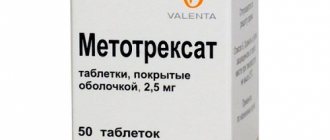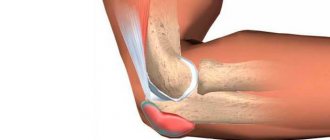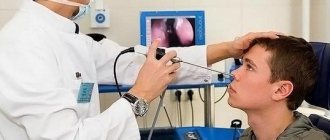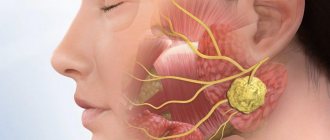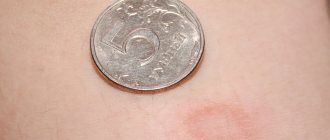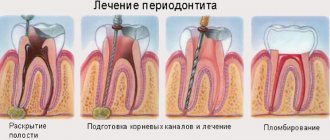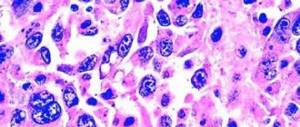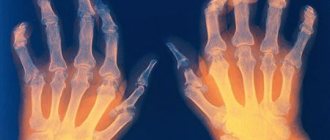Often, people who have psoriasis are faced with a problem such as psoriatic arthritis. This pathology is a type of joint inflammation. Psoriasis is a chronic skin disease characteristic of young people (from 15 to 45 years). The prevalence of this pathology among the population reaches 4%. With timely and adequate treatment, the health prognosis is relatively favorable. What are the causes, symptoms and treatment of arthritis due to psoriasis?
What is psoriatic arthritis?
For many people, the term “psoriasis” is associated with a disease that is accompanied by itching, scaly rashes and brittle nails. Indeed, psoriasis is a skin disease. But about 30% of patients diagnosed with psoriasis develop a form of inflammatory arthritis known as psoriatic arthritis (PsA). PsA is an autoimmune disease caused by an erroneous attack by the immune system on healthy body tissues, in this case the joints and skin. An abnormal protective reaction provokes inflammation, accompanied by swelling and stiffness of the joints. Inflammation can affect the entire body, and if not treated promptly and decisively, it can lead to permanent atrophy of joints and tissues.
For most people with psoriatic arthritis, skin symptoms appear before joint symptoms. However, sometimes tenderness and stiffness of the joints are primary. In some cases, psoriatic arthritis occurs without any skin changes.
The disease can “dormant” in the body for a long period until its exacerbation is provoked by some external factor, for example, a common respiratory tract infection.
Types of psoriatic arthritis:
There are five types of psoriatic arthritis:
- Symmetrical psoriatic arthritis. Up to 50% of PsA cases belong to this type. It is called symmetrical because it affects the joints on both sides of the body. This type of arthritis is similar to rheumatoid arthritis.
- Asymmetric psoriatic arthritis . This type of psoriatic arthritis is often mild and occurs in 35% of patients with PsA. It is called asymmetrical because it does not affect the same joints on different sides of the body.
- Distal psoriatic arthritis. This type of disease causes inflammation and stiffness in the tips of the fingers, toes, and nails, accompanied by pinpoint pigmentation, white spots, and raised nail beds.
- Spondylosis. Signs of this type of PsA include pain and stiffness in the spine. Often symptoms are localized in the neck area.
- Arthritis deformans. Although this form of the disease is considered the most severe among the types of PsA, it affects only 5% of patients with this pathology. It causes deformation of the small joints in the tips of the fingers and toes and can destroy them almost completely.
Who is susceptible to the disease?
According to the Annals of the Rheumatic Diseases, psoriatic arthritis occurs in 6% to 42% of people with psoriasis. The pathology usually affects people between 30 and 55 years of age, but can also develop in childhood. Unlike many autoimmune diseases, men and women are equally at risk for developing this condition.
Clinical signs and symptoms
A characteristic feature of psoriatic arthritis is damage to the distal interphalangeal joints, often in combination with “psoriatic” changes in the nails.
There are three forms of psoriatic arthritis: ■ Asymmetric oligo-monoarthritis of large joints (for example, knees), reminiscent of spondyloarthropathy, in combination with damage to one or two interphalangeal joints and dactylitis (tenosynovitis and arthritis of the distal and proximal interphalangeal joints) of the hands and/or feet
■ Symmetrical polyarthritis of small joints of the hands and feet, wrist, knee and shoulder joints. According to its clinical manifestations, it is indistinguishable from RA, but is often accompanied by involvement of the distal interphalangeal joints and the development of ankylosis of the distal and proximal interphalangeal joints.
The development of symmetrical arthritis in psoriasis in the absence of the listed clinical manifestations and seropositivity for the Russian Federation should be interpreted as a combination of two diseases (psoriasis and RA), and not as psoriatic arthritis.
Symptoms of psoriatic arthritis
Symptoms of psoriatic arthritis vary from person to person. Many of them are common to other forms of arthritis, which makes diagnosing this type of disease difficult. Below are descriptions of the most common symptoms and the conditions for which they occur.
Painful, swollen joints
Psoriatic arthritis usually affects the ankles, knees, fingers, toes, and lower back. Lumbar pain can also be a symptom of ankylosing spondylitis, a type of inflammatory arthritis that causes displacement or compression. In addition, there may be swelling of the joint in the tip of the finger, which can easily be confused with gout, a form of inflammatory arthritis that usually affects only one joint.
Stiffness
Typically, after a night's sleep or a long period of inactivity, the joints become stiff. This type of stiffness is common in people suffering from osteoarthritis.
Sausage-shaped fingers and toes
Many patients with PsA develop swelling of the entire length of the fingers and toes, known as dactylitis. This symptom helps differentiate psoriatic arthritis from rheumatoid arthritis (RA), in which swelling is usually localized only to the joint.
Tendon or ligament pain
In people with psoriatic arthritis, enteritis often progresses—pain or tenderness on palpation, which is localized at the site of attachment of tendons or ligaments to the bone. It usually develops in the heel (Achilles tendonitis) or on the bottom of the foot (plantar fasciitis), but can also affect the elbow (called tennis elbow). Each of these conditions can develop both with psoriatic arthritis and due to sports injuries or excessive stress.
Skin rashes and changes in nail plates
Psoriatic arthritis develops with psoriasis, and therefore the symptoms of lesions include thickening and redness of the skin with flaky silver-white “scaly” spots. The nails become pitted and look like they have some kind of infection; Also, the nails may completely separate from the bed. These signs are unique to psoriasis and psoriatic arthritis, which makes it easier to confirm the diagnosis.
Fatigue
People with psoriatic arthritis often suffer from general fatigue. The same symptom is characteristic of rheumatoid arthritis.
Limited range of motion
A reduction in the amplitude and degree of freedom of movement of the limbs and joints is a sign of PsA and other types of arthritis.
Eye problems
Patients with psoriatic arthritis may develop eye inflammation. It may be accompanied by redness, irritation, blurred vision (uveitis), or redness and tenderness of the tissue around the eyes (conjunctivitis or pink eye).
Exacerbations
Many people experience frequent periods of exacerbation of the disease and the intensity of symptoms, but for other patients such outbreaks are rare. This alternation of the manifestation of the disease with a weakening of its manifestations is also characteristic of RA.
Psoriatic arthritis is closely related to inflammatory bowel disease, particularly the form known as Crohn's disease. This condition causes diarrhea and other gastrointestinal problems. The inflammation that accompanies PsA can damage the lungs, causing interstitial lung diseases that cause shortness of breath, cough, and weakness. Chronic inflammation can damage blood vessels, increasing the risk of heart attacks and strokes. Patients with PsA often develop metabolic syndrome, a group of conditions characterized by obesity, high blood pressure and dangerous levels of cholesterol. Other disorders that may accompany PsA include depression, an increased risk of osteopenia (thinning bones) and osteoporosis, and a higher than average risk of developing gout.
Causes of psoriatic arthritis
The causes of psoriatic arthritis (PsA) are not known with certainty. Experts believe that some people are predisposed to an autoimmune disease called psoriatic arthritis. In fact, research supports a stronger genetic link and family history for this disease compared to other autoimmune rheumatic diseases. Up to 40% of patients diagnosed with psoriatic arthritis and psoriasis have relatives affected by these diseases.
Not all people with psoriasis develop psoriatic arthritis. Psoriasis is not contagious, but the condition can be triggered by a streptococcal throat infection. In addition to infection, experts cite extreme stress or trauma, accompanied by an “overload” of the immune system in people who are genetically more susceptible to PsA, as potential causes of PsA development.
Forecast
The disease has an unpredictable course. Usually it is benign. However, sometimes the disease is malignant and causes joint destruction.
The prognosis is determined individually. It all depends on the frequency and severity of relapses, the correctness of the selected therapy, and the duration of use of medications.
Psoriatic arthritis is a rather complex pathology that can cause negative health consequences. To cope with the disease, you must consult a doctor in a timely manner and strictly follow his recommendations.
Diagnosis of psoriatic arthritis
Diagnosing psoriatic arthritis can be confusing because its symptoms often mimic those of other forms of inflammatory arthritis such as rheumatoid arthritis (RA) or gout. It can also be easily confused with osteoarthritis (OA), the most common type of arthritis.
To make an accurate diagnosis, the primary care physician will likely refer the patient to a rheumatologist, a specialist in arthritis and musculoskeletal disorders. The diagnosis is based on a number of techniques that combine a thorough examination of the medical history, analysis of the results of a physical examination and medical tests.
Disease history
Since certain conditions can be hereditary, the doctor will review the history of the disease both in the patient and in his/her relatives.
Additional data needed to diagnose PsA include:
- Description of symptoms
- Details about when and how soreness or other signs progressed
- Location of pain, stiffness or other symptoms
- Identifying symptoms that affect the patient's daily activities
- Determine the range of problems that may be accompanied by these symptoms, as well as compiling a list of medications currently used
Physical examination
The rheumatologist will perform a physical examination, looking for swelling and inflammation of the joints. In addition, he will examine the skin for signs of psoriasis, and will also check for abnormalities on the fingernails and toenails. It should be noted that the symptoms of psoriasis are not always clearly visible. Its manifestations can be localized on the scalp, behind the ears, in the navel or between the buttocks.
Diagnostic tests
Your doctor may need an x-ray to look for changes in your bones or joints. Blood tests will be done to look for markers of inflammation. Such studies include analysis of C-reactive protein and rheumatoid factor (RF). In people with PsA, rheumatoid factor is almost always negative. If the RF is positive, this allows us to first suspect the development of RA.
An erythrocyte sedimentation rate (ESR) test is often prescribed. Depending on the elevated ESR level, one can judge the intensity of inflammation. To exclude the possibility of gout or infectious arthritis, a laboratory puncture of the joint fluid may be performed.
Because diagnosing psoriatic arthritis can be difficult, people are sometimes initially told that they have another form of arthritis and only later discover that they have psoriatic arthritis.
Exclusion of similar conditions
PsA symptoms can mimic other diseases. The most common misdiagnoses in such cases are: osteoarthritis, rheumatoid arthritis and gout. Listed below are some tips to help avoid misdiagnosis of psoriatic arthritis.
- If one joint becomes swollen and extremely painful overnight, it is most likely gout. The pain progresses rapidly and intensely.
- If joint swelling is mild or absent, osteoarthritis is most likely. Pain with this pathology usually appears after exercise.
- If the pain is felt in the same joints on both sides of the body (symmetrically), this symptom is characteristic of RA. In PsA, joint pain is usually asymmetrical, meaning it is only felt at a joint on one side of the body. For example, only one knee may be affected by psoriatic arthritis.
If joint pain is most intense for a few minutes in the morning or after a long period of inactivity, it could be a symptom of either PsA or RA.
Swelling of the fingers and toes along their entire length suggests PsA. This condition is called dactylitis, or “sausage fingers.”
If symptoms of psoriasis and thimble toenail syndrome develop first, followed by joint pain, PsA is most likely the cause, especially if joint swelling is present. It is possible to develop psoriasis, against the background of which a type of arthritis progresses, which is not psoriatic.
Diagnosis of pathology
Diagnosis is made based on concomitant diseases. A history of psoriasis can distinguish psoriatic arthritis from rheumatoid arthritis.
An important factor on the basis of which the primary diagnosis is made is damage to the nail plates, which makes it possible to immediately associate arthritis with psoriasis. Patients are shown x-rays of the affected area.
A general blood test can detect inflammation. When diagnosing, it is important to exclude rheumatoid arthritis, for which blood tests for rheumatoid factors are performed.
Additionally, sampling of synovial fluid is practiced with subsequent study of its composition.
In recent years, research on antibodies to cyclic citrullinated peptide has begun to develop. At the moment, this is the most effective method for determining the diagnosis, with a specificity of almost 100%. Of the 100 people who were found to have antibodies to cyclic citrullinated peptide, 80 were actually diagnosed with rheumatoid arthritis.
changes in the inflammatory nature of the synovial fluid, as well as an increased level of neutrophils in it;
votes, average:
What other tests for arthritis need to be taken and what to pay attention to.
In order to determine whether a patient suffers from rheumatoid arthritis or not, a good doctor looks at several indicators at once: the symptoms and manifestations of the disease, the results of laboratory tests, X-ray data, studies of the synovial fluid of the affected joints, and also keeps in mind specially designed diagnostic tests. RA criteria.
the appearance of rheumatoid nodules (nodes under the skin on the extensions and protrusions of bones);
- 5,00
- The results of this analysis are important for the diagnosis of arthritis. However, it is not always possible to rely only on this analysis. The fact is that changes in the synovial fluid can be a consequence of injuries, bruises of the joints. Therefore, the rheumatologist makes the decision to conduct a study of synovial fluid based on the available results of other studies.
- systemic RA, etc.
- Platelets (more than 400•109/l) – thrombocytosis
- The ACCP blood test is performed quite simply and quickly. Material for research is taken from a vein. Blood serum is needed directly for the procedure itself, so after collection the venous blood is centrifuged. If laboratory calculations do not take place immediately, then you need to remember that the serum can be stored for a week at a temperature of 2 degrees to 80°C and in no case more. Also, in the most extreme cases, freezing at a temperature of -200°C is possible, but categorically you should not allow repeated defrosting and freezing.
- Why is the analysis prescribed:
- joint pain;
- inflammation affects at least three groups of joints with the formation of excess fluid in the joints and swelling of nearby tissues;
- If this disease is suspected, a number of laboratory tests are prescribed that will help the doctor make the correct diagnosis.
- Let's look at each of these points.
- X-ray signs (bone erosion, osteopenia - reveals x-rays of the hand and wrist joints);
- out of 5) Loading…
- The main thing to pay attention to in the analysis results:
- Plasma fibrinogen (normal 2.0 - 4.5 g/l serum) - being an acute phase protein, during the activation of the inflammatory process, its concentration increases sharply.
rheumatoid arthritis (thrombocytosis in RA indicates high disease activity).
Biochemical blood test
The blood test is carried out in a test tube and the method of optical cytofluometry is used - this is the scattering of a laser beam in different liquid media. As a rule, the result should be ready on the second day after taking it. Then the patient’s normality or lack thereof is determined.
- for detection of rheumatoid arthritis at the initial stage of the disease - less than 6 months;
redness of the skin in the area of the diseased joint;
joint inflammation affects the metacarpophalangeal, proximal interphalangeal and wrist joints;
To identify rheumatoid arthritis, it is important to know what the most common signs are:
Ragocytes are not detected in normal SF, but in RA they reach 40% or more, depending on the degree of activity of the local inflammatory process.
First signs
Analysis for antibodies to cyclic citrullinated peptide (ACCP) detects RA in 70% of patients whose RF values were within normal limits.
Erythrocyte sedimentation rate (ESR)
Treatment of psoriatic arthritis
There are a number of over-the-counter and prescription medications available to treat psoriatic arthritis. Some of these medications help get rid of both psoriasis and psoriatic arthritis; some medications affect only the skin, while others affect the joints. Some drugs can affect the course of the disease by inhibiting the overactivity of the immune system.
Drugs for the treatment of psoriatic arthritis
NSAIDs. Nonsteroidal anti-inflammatory drugs (NSAIDs) are usually intended for internal use, although some should be applied directly to the skin. These medications not only relieve inflammation, but can also reduce pain and swelling. The most well-known over-the-counter NSAIDs are ibuprofen (Advil, Motrin) and naproxen sodium (Aleve) - although there are many other painkillers available. In addition, over a dozen prescription NSAIDs are used to treat PsA. The biggest risks of taking these medications are an increased risk of heart attack or stroke, along with irritation of the stomach lining and the possibility of severe bleeding.
Corticosteroids. These medications have the same properties as the anti-inflammatory hormone cortisol, produced by the human adrenal gland. Oral administration of corticosteroids such as prednisone can relieve inflammation, but a long-term course of drugs may be accompanied by side effects: swelling of the face, weight gain, development of osteoporosis, and others. Temporary relief of inflammatory processes can be achieved by direct injections of corticosteroids into the affected joint.
Local impact. Topical treatments involve applying medications directly to the skin to treat the flaky, itchy plaques caused by psoriasis. For this purpose, creams, gels, lotions, shampoos, sprays or ointments are used, available either by prescription or over the counter. Over-the-counter remedies include salicylic acid, which stimulates the exfoliation and cleansing of the affected epidermis, and coal tar, which slows the rapid growth of plaques and relieves itching and inflammation. Prescription topical medications include corticosteroids and/or vitamin derivatives. Prescriptions often include calcitriol, a natural form of vitamin D3; calcipotriol – a synthetic analogue of vitamin D3; calcipotriene in combination with the coricosteroid dipropionate betamethasone; tazarotene (vitamin A derivative); anthralin is a synthetic analogue of chrysarobin, a substance obtained from the South African ararob tree.
Light therapy. Another method of treating psoriasis is photo or light therapy. During this treatment, the skin is regularly exposed to ultraviolet light. For safety reasons, procedures are carried out under medical supervision.
BMPP. Disease-modifying (disease-modifying) antirheumatic drugs (DMARDs) are a whole group of medications that not only relieve symptoms, but also inhibit the chemical processes associated with inflammation and joint deformation. Most of them are taken orally. According to the American College of Rheumatology, the most commonly prescribed drugs for the treatment of psoriatic arthritis are DMARDs. Azathioprine may also be prescribed. are methotrexate, sulfasalazine, cyclosporine and leflunomide. Azathioprine may also be prescribed. The newest DMARD drug is apremilast, approved for use in 2014. Its action is to inhibit phosphodiesterase 4 (PDE4), an enzyme that is associated with the development of inflammatory processes. Studies have confirmed the effectiveness of apremilast in reducing the number of joints that experience tenderness and swelling.
Biological drugs. Complex drugs, which are called bioloic, are technically a subset of DMARDs, and “know how” to stop inflammatory processes at the cellular level. They are typically administered by injection or infusion. There are two types of biologics approved for the treatment of psoriatic arthritis. The first type is called tumor necrosis factor-alpha (TNF-α). Medicines of this type are inhibitors of a specific protein produced by immune cells that signals other cells about the onset of the inflammatory process. These include etanercept, adalimumab, golimumab, infliximab and certolizumab. The second type of drug includes ustekinumab, which blocks the biological activity of two pro-inflammatory proteins - interleukin-12 and interleukin-23. Although biological drugs can be very effective, they suppress the immune system, which increases the risk of infection.
Self-control for psoriatic arthritis
Taking a proactive role in the treatment process is an important step in controlling the symptoms of psoriatic arthritis. This process is called self-control or self-service. It will help the patient reduce the intensity of relapses and be healthier overall.
Listed below are a number of self-management approaches that are recommended for people affected by psoriatic arthritis to practice daily.
Move
Regular physical activity, and in particular aerobic activities such as walking or cycling, will help maintain joint mobility and improve overall health and well-being. It is important to get rid of extra pounds, since excess weight puts additional stress on the joints.
Eat right
A healthy, balanced diet high in fresh fruits and vegetables and low in fat, sugar and salt can improve the overall health of people with psoriatic arthritis. In addition, it will help you keep your weight under control. Eating too much unhealthy food can make you feel tired and sluggish.
Limit your alcohol intake
Excessive amounts of alcohol can inhibit the effect of medications or increase side effects from taking medications. Talk to your doctor about whether you can drink alcohol during your prescribed treatment for psoriatic arthritis.
Quit smoking
Smoking is harmful to human health. Any period of life is suitable to get rid of this habit or at least limit smoking.
Control the impact of stress
Excessive stress can worsen symptoms of relapse or make daily activities more difficult. Meditation, listening to soothing music, walking, joining a support group and therapeutic activities such as yoga or tai chi can reduce the effects of stress.
Protect your skin
To treat psoriasis, it is important to moisturize your skin regularly. Applying lotions or creams containing aloe vera, jojoba, capsaicin or zinc pyrithione to the affected areas will help. To soothe skin irritation, short, warm (not hot) baths with the addition of oatmeal oil, bath oils, Dead Sea salt or Epsom salt (magnesia) followed by applying a moisturizer will help to soothe skin irritation. Make it a habit to use moisturizer after your daily shower, bath or swim. The method for removing “scales” from affected areas is occlusion, in which a moisturizing composition or topical preparation is applied to the skin, followed by wrapping with film, nylon or cotton cloth. Humidifiers soften dry areas. Occlusion should not be performed using steroid creams. Before using the technique or any products, consult your doctor.
Light therapy
Periodic, dosed exposure to ultraviolet light, known as phototherapy, has been found to suppress psoriatic rashes. Phototherapy sessions are supervised treatments performed in a doctor's office or at home using an ultraviolet light source. Short-term (lasting 5 to 10 minutes) sunbathing sessions may also be helpful. Just remember to avoid burns by applying sunscreen to areas not affected by psoriasis.
Pay attention to laundry and wardrobe
To reduce the risk of skin reactions, wash your clothes with fragrance-free products and avoid using fabric softeners. Choose loose clothing that will not irritate the affected skin. Products made from natural soft fibers (cotton, for example) are more gentle on the skin and provide greater comfort in the warm season.


